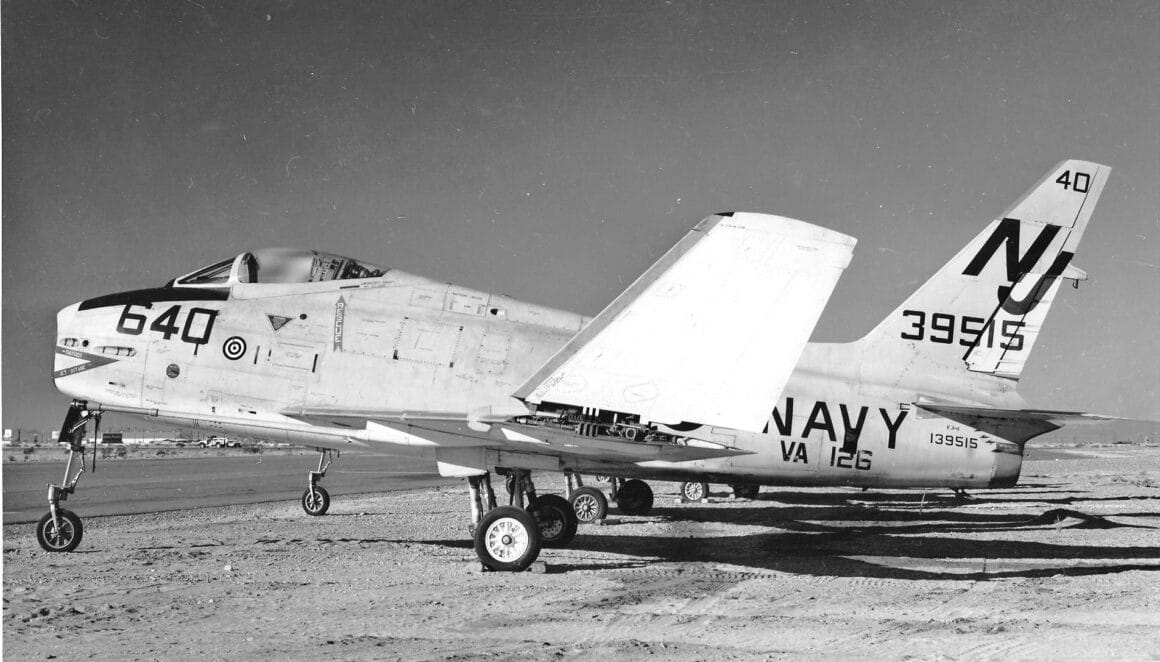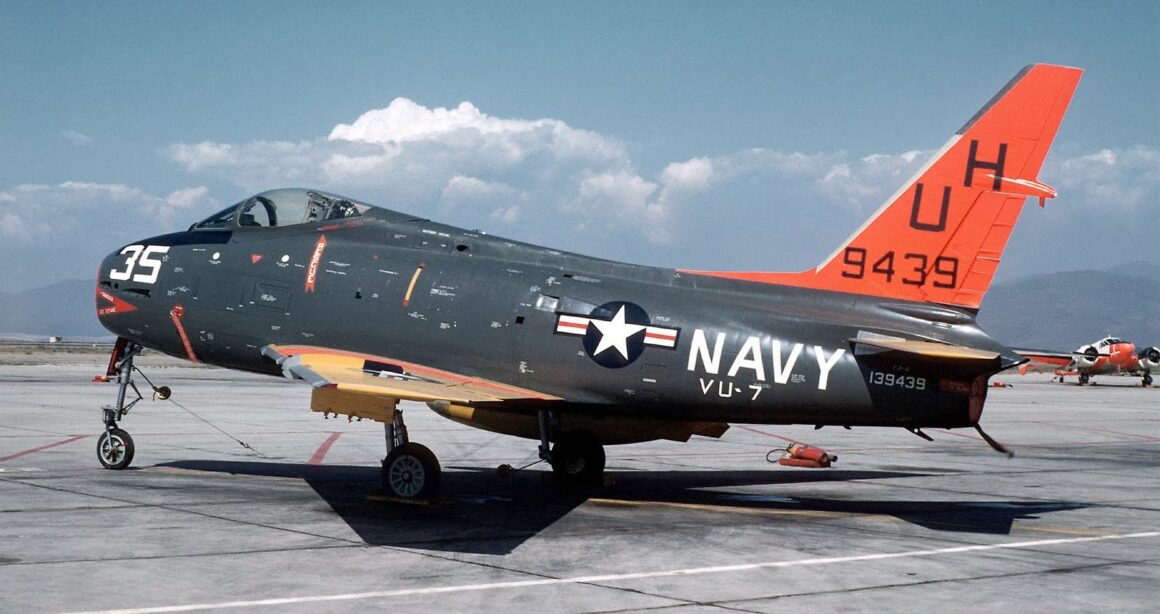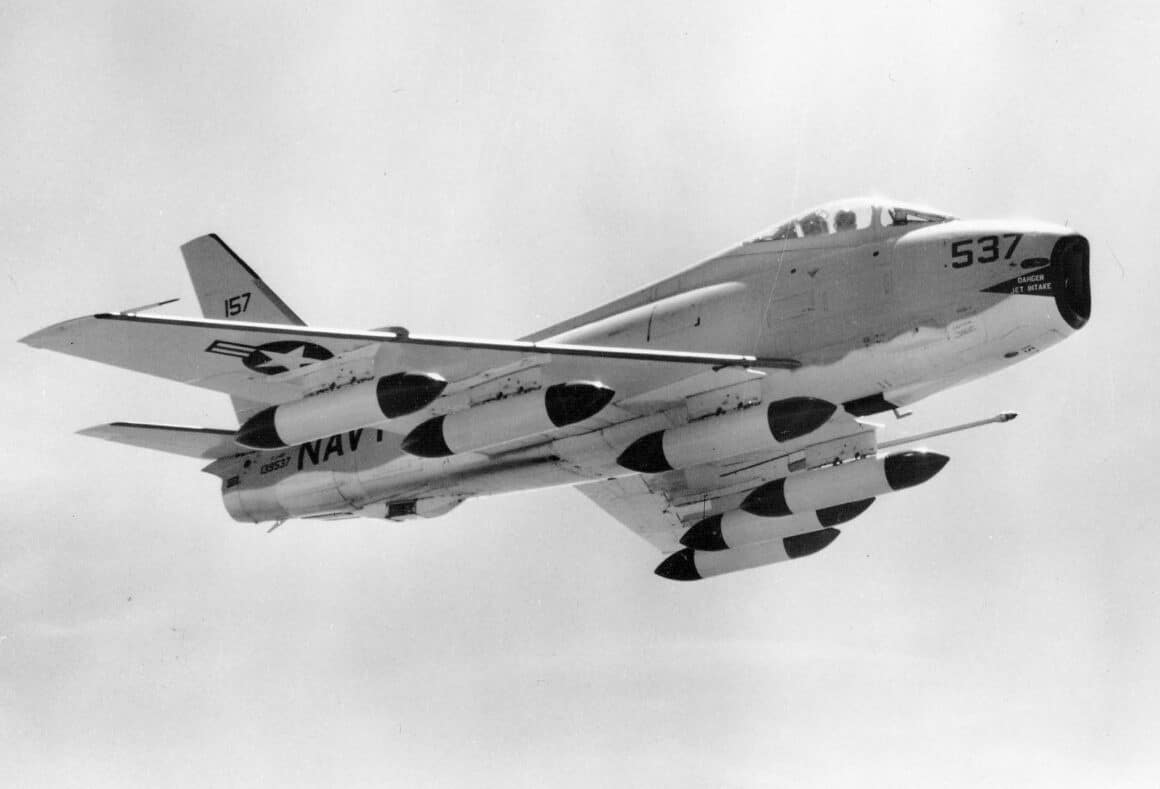Clearly Different- the FJ-4
As much as the FJ-3 resembled the FJ-2, the FJ-4 was clearly a different animal. The jet had a longer-span but thinner and more tapered wet wing with one-piece forged skin panels, ailerons relocated to the mid-span position, two and a half-feet wider tracked landing gear, a longer and stouter nose gear strut, a taller vertical stabilizer, and a pronounced fairing that that ran from aft of the raised cockpit all the way down the top of the deeper fuselage (with additional internal fuel tankage) to the base of the vertical stabilizer.
The empennage was redesigned with thinner airfoils. Even though the FJ-4 carried 50% more fuel than the FJ-3, much of it in the wings, the jet was actually lighter thanks to the omission of some armor and a reduction in the ammunition capacity. Work on the FJ-4 began in June 1953. The first FJ-4 flew on 28 October 1954, and deliveries of the ultimate Fury began in February 1955.

Into Service
Marine Corps squadron VMF-451 was the first squadron to gain operational status with the FJ-4. All 152 FJ-4s delivered by NAA went to VMF-232, VMF-235, and VMF-451. VA-126 was the only Navy squadron to operate the FJ-4, which was the Fleet Replacement Squadron (FRS) for the FJ-4. VF-124 would also be the FRS for the FJ-4B.

Doomsday Furies
The fighter-bomber version of the FJ-4 was designated FJ-4B. FJ-4Bs had larger airbrakes, strengthened landing gear, and still larger wings with six underwing hardpoints- one of which (the inboard port station- station 4) was wired for carrying nuclear weapons.
Doomsday Furies were equipped with the Low-Altitude Bombing System (LABS). FJ-4s were also equipped with refueling probes under their port wings and could carry up to four AIM-9 Sidewinder missiles or the Martin ASM-N-7 Bullpup air-to-surface missile. When the LABS system was not installed, the radar-ranging lead-computing gunsight in the upper nose improved the air-to-air gunnery capability of the FJ-4B.

Reserves and Retirement
VA-214 took the FJ-4B on its first operational cruise aboard the USS Hornet (CVA-12). Eventually, a total of 14 Navy and Marine Corps squadrons operated the FJ-4B. VA-216 flew the last deployment of the FJ-4B in 1962 aboard the USS Hancock (CVA-19).
When the Tri-Service Designation system became effective in 1962, FJ-4s were redesignated F-1Es, and FJ-4Bs became AF-1Es. AF-1Es were flown by Naval Reserve and Marine Corps Reserve squadrons until the late 1960s. NAA built a total of 1,115 FJ-1, FJ-2, FJ-3, and FJ-4 Furies.

The Video
Here’s a link to a great video featuring Furies from VF-173 Jesters operating in the Med. Don’t miss it!
Fury Trivia
On 4 January 1956, an FJ-3 Fury flown by CDR Ralph L. Werner of VF-21 became the first aircraft to land aboard the new super carrier USS Forrestal (CVA-59).
Thanks to the F-86 being so badly needed for the Korean War, NAA’s ability to deliver FJ-2 Furies to the Navy was severely diminished. The F-86 was simply a higher priority. In fact, the first FJ-2 (BuNo 131927) was delivered in November 1952. But by the time the Korean War ended eight months later, NAA had delivered only six more FJ-2s to the Navy.

Some FJ-4Bs had the port pair of 20-millimeter cannons removed and replaced by a standby generator system, considered essential for a strike aircraft with a potential nuclear attack mission tasking. In the event of a primary generator failure, it would be nigh on impossible to fly at night or under instrument conditions for more than a few minutes on battery power.
FJ-4Bs were also equipped with a new Martin-Baker ejection seat designed to allow safe ejection from the jet at lower altitudes.

The downright hairiest Fury was the FJ-4F. In August 1955, it was decided to mount a Rocketdyne AR-1 rocket engine in a couple of early-production FJ-4s. The AR-1, capable of producing 5,000 pounds of thrust kick in the tail, was fueled by a mixture of JP-4 and hydrogen peroxide. FJ-4Fs were also sometimes equipped with a ventral fuel tank for the hydrogen peroxide rocket fuel. It’s said performance was ‘impressive,” but the only two FJ-4Fs built were retired later in 1955.
